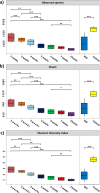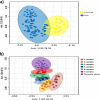Alterations in skin microbiome mediated by radiotherapy and their potential roles in the prognosis of radiotherapy-induced dermatitis: a pilot study
- PMID: 33664352
- PMCID: PMC7933139
- DOI: 10.1038/s41598-021-84529-7
Alterations in skin microbiome mediated by radiotherapy and their potential roles in the prognosis of radiotherapy-induced dermatitis: a pilot study
Abstract
Radiotherapy-induced dermatitis (RID) is an inflammatory cutaneous disorder that is acquired as an adverse effect of undergoing radiotherapy. Skin microbiome dysbiosis has been linked to the outcomes of several dermatological diseases. To explore the skin microbiota of RID and deduce their underlying impact on the outcome of RID, cutaneous microbiomes of 78 RID patients and 20 healthy subjects were characterized by sequencing V1-V3 regions of 16S rRNA gene. In total, a significantly apparent reduction in bacterial diversity was detected in microbiomes of RID in comparison to controls. Overall, the raised Proteobacteria/ Firmicutes ratio was significantly linked to delayed recovery or tendency toward the permanence of RID (Kruskal Wallis: P = 2.66 × 10-4). Moreover, applying enterotyping on our samples stratified microbiomes into A, B, and C dermotypes. Dermotype C included overrepresentation of Pseudomonas, Staphylococcus and Stenotrophomonas and was markedly associated with delayed healing of RID. Strikingly, coexistence of diabetes mellitus and RID was remarkably correlated with a significant overrepresentation of Klebsiella or Pseudomonas and Staphylococcus. Metabolic abilities of skin microbiome could support their potential roles in the pathogenesis of RID. Cutaneous microbiome profiling at the early stages of RID could be indicative of prospective clinical outcomes and maybe a helpful guide for personalized therapy.
Conflict of interest statement
The authors declare no competing interests.
Figures




References
-
- Abo-Touk N. Cancer registry report in Mansoura University Hospital, Egypt in 2015. Forum Clin. Oncol. 2020 doi: 10.2478/fco-2019-0003. - DOI
-
- Shimaa, A. E., Refaat, R. S., Fadia, A. M. & Asmaa, T. Pattern of Malignant Tumors among Cancer Patients during the Year 2014 in Minia Governorate, Egypt. Egypt. J. Community Med38, (2020).
MeSH terms
Substances
LinkOut - more resources
Full Text Sources
Other Literature Sources

